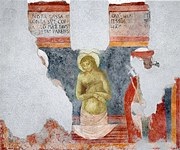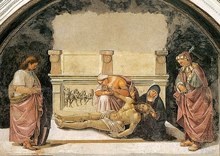


Detail from the Pietà with SS Faustinus and Peter Parenzo (ca. 1504)
by Luca Signorelli, Cappellina dei Corpi Santi, Duomo, Orvieto - see below
An entry in the Roman Martyrology under 29th July reads: “At Rome, on the Via Portuensis, the holy martyrs Simplicius, Faustinus, and Beatrice, in the time of Emperor Diocletian. The first two, after being subjected to many different torments, were condemned to suffer death; Beatrice, their sister, was smothered in prison for the confession of Christ”.
According to local tradition, the bodies of SS Simplicius and Faustinus were thrown into the Tiber, but their sister Flora managed to retrieve and bury them.
The connection between Orvieto and St Faustinus is unclear. He shares his feast day with a local martyr, St Faustinus of Civitas Martana: it could be that the legends of a local and a Roman martyr were confused at an early date.
A suburban district of this name, and presumably therefore a church with this dedication, was recorded in a suburb below the city in 1292 and in 1377, but it had disappeared by 1402. It seems likely that presumed relics were preserved in the Duomo by that time, probably with those of St Peter Parenzo were moved to a site to the left of the high altar. The feast of St Faustinus on 29th July was recorded as a holiday in the statutes of 1421: it was celebrated annually in the Duomo from that date until 1900.
A series of documents point to a resurgence in the cults of SS Faustinus and Peter Parenzoin 1468-9:
-
✴four payments were made in March-August 1468 for a “cassa dei corpi santi”, a new painted wooden sarcophagus for the relics of the two saints;
-
✴their two reliquaries were taken in procession around the city in September, presumably as part of their translation to the new sarcophagus;
-
✴a week later, payments were made for the altar of the Cappellina dei Corpi Santi, a small chapel on the right of the Cappella Nuova;
-
✴the completion of the small chapel was celebrated in October 1368;
-
✴a week later, payments were made (inter alia) for the sealing of the new sarcophagus and for a new fresco by Pietro di Niccolò Baroni for the chapel (see below); and
-
✴payments for lamps and candles for the chapel continued into 1369.
Pietà with SS Faustinus and Peter Parenzo (1468)

As noted above, Pietro di Nicola Baronio was paid to paint this fresco in the Cappellina dei Corpi Santi in the the Cappella Nuova in 1468. The inscription above the main scene, which is in two columns, commemorates St Faustino and St Peter Parenzo, intercessors for the city, whose bodies lay in the “cassa dei corpi santi” in the chapel. It reads:
IN ISTA CASSA R[E]
CONDITA SUNT CORP[O]
RA SANCTORUM MARTIRUM FAUST
[INI] ET PETRY PARENS[I]
QUORUM MERITIS INTER
CESSIONIBUS DEUS [CIVITATEM]
HANC [ELUIT] [...]
This fresco, which depicted the two saints flanking an image of the Pietà, was covered by a wall in 1502-3, but recovered and detached during the restoration of the chapel in 1996. It is now in the Museo dell' Opera del Duomo.
Pietà with SS Faustinus and Peter Parenzo (ca. 1504)

The contract between the Opera del Duomo and Luca Signorelli of 1500 included the redecoration of the Cappellina dei Corpi Santi. Payment for the building of a wall in front of the existing fresco (above) is recorded in 1502-3. The new fresco, which was executed on this wall, depicts the Virgin's lamentation over the Dead Christ with St Mary Magdalen, St Faustinus and St Peter Parenzo. St Faustinus is depicted with a rope around his neck, and with the millstone meant ensure that his body would sink in the Tiber. The scene is set in front of a sarcophagus that contains a fictive relief of the Deposition of Christ. Scenes of the martyrdoms of SS Faustinus and Peter Parenzo are depicted in tondi in the shallow sidewalls of the chapel.
Return to Saints of Orvieto.

